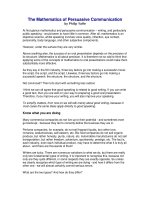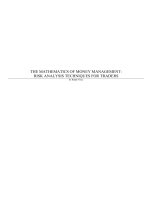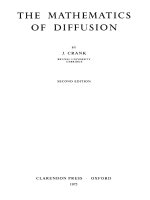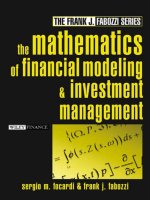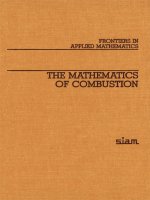the mathematics of combustion
Bạn đang xem bản rút gọn của tài liệu. Xem và tải ngay bản đầy đủ của tài liệu tại đây (13.38 MB, 267 trang )
THE
MATHEMATICS
OF
COMBUSTION
FRONTIERS
IN
APPLIED MATHEMATICS
H. T.
Banks,
Managing
Editor
This series
is
intended
to
serve
as a
provocative intellectual
forum
on
both emerg-
ing
or
rapidly developing research
areas
and fields
that
are
already
of
great interest
to a
broad spectrum
of the
scientific community.
The
Mathematics
of
Combustion
is the
second volume
in
this
series.
The first is
The
Mathematics
of
Reservoir Simulation, edited
by
Richard
E.
Ewing.
Editorial
Board John
D.
Buckmaster Charles
J.
Holland
Robert
Burridge
Alan Laub
Jack
J.
Dongarra
Robert Voigt
Richard
E.
Ewing
THE
MATHEMATICS
OF
COMBUSTION
JOHN
D.
BUCKMASTER,
EDITOR
SiaJTL
PHILADELPHIA
1985
Copyright
©
1985
by
Society
for
Industrial
and
Applied Mathematics.
All
rights reserved.
Library
of
Congress Catalog Card Number: 85-50339
ISBN: 0-89871-053-7
CONTENTS
Contributors
vii
Foreword
H. T.
Banks
ix
Preface John
D.
Buckmaster
xi
Chapter
I. An
Introduction
to
Combustion Theory
John
D.
Buckmaster
3
Chapter
II.
Sensitivity
Analysis
of
Combustion Systems
Herschel Rabitz
47
Chapter III. Turbulent Combustion
F. A.
Williams
97
Chapter
IV.
Detonation
in
Miniature
Wildon
Pickett
133
Chapter
V.
Finite Amplitude Waves
in
Combustible Gases
J. F.
Clarke
183
Index
247
v
This page intentionally left blank
CONTRIBUTORS
JOHN
D.
BUCKMASTER
is
Professor
of
Aeronautical
and
Astronautical Engineering, University
of
Illinois, Urbana, Illinois.
J. F.
CLARKE
is
Professor
of
Theoretical Gas-Dynamics, College
of
Aeronautics,
Cranfield
Institute
of
Technology, Cranfield, Bedford, England.
WILDON
FICKETT
is
with
Los
Alamos National Laboratory,
Los
Alamos,
New
Mexico.
HERSCHEL
RABITZ
is
Professor
of
Chemistry, Princeton University, Princeton,
New
Jersey.
F. A.
WILLIAMS
is
Professor
of
Mechanical
and
Aerospace
Engineering, Princeton University,
Princeton,
New
Jersey.
Vll
This page intentionally left blank
FOREWORD
This
is the
second volume
in the
SIAM
series Frontiers
in
Applied Math-
ematics.
This continuing series
will
focus
on
"hot
topics"
in
applied math-
ematics,
and
will
consist
of, in
general, unrelated volumes, each dealing with
a
particular
research
topic
that should
be of
significant
interest
to a
spectrum
of
members
of the
scientific community. Distinguished scientists
and
applied
mathematicians
will
be
solicited
to
contribute their points
of
view
on
"state-
of-the-art" developments
in the
topics addressed.
The
volumes
are
intended
to
provide provocative intellectual
forums
on
emerging
or
rapidly developing fields
of
research
as
well
as be of
value
in
the
general education
of the
scientific community
on
current topics.
In
view
of
this latter goal,
the
solicited articles
will
be
designed
to
give
the
nonexpert,
nonspecialist some appreciation
of the
goals, problems, difficulties, possible
approaches
and
tools,
and
controversial aspects,
if
any,
of
current
efforts
in
an
area
of
importance
to
scientists
of
varied persuasions.
Each volume
will
begin with
a
tutorial article
in
which technical terms,
jargon, etc.
are
introduced
and
explained. This
will
be
followed
by a
number
of
research-oriented
summary contributions
on
topics
relevant
to the
subject
of
the
volume.
We
hope that
the
presentations
will
give mathematicians
and
nonmathematicians alike some understanding
of the
important
role
mathe-
matics
is
playing,
or
perhaps
might
play,
in
what academicians
often
eu-
phemistically
call "the real
world."
We
therefore expect each volume
to
contribute
some further understanding
of the
important scientific interfaces
that
are
present
in
many applied problems, especially those
found
in
indus-
trial endeavors.
At
the
printing
of
this volume,
a
number
of
other volumes
are
already
in
progress. Volume
3
will
focus
on
seismic exploration,
and
Volume
4 on
emerging
opportunities related
to
parallel computing. Other topics
in
sci-
entific
computing
are
among those currently under consideration
for
future
volumes.
Members
of a
rotating editorial board will encourage active par-
ix
X
ticipation
of the
mathematical
and
scientific community
in
selection
of
topics
for
future
volumes.
The
series
is
being launched with several volumes
in
"energy mathemat-
ics"
and the
editorial board gratefully acknowledges
the
faculty
and
admin-
istration
of the
University
of
Wyoming
for
their cooperation
in
connection
with
the
Special Year
on
Energy-Related Mathematics held
in
Laramie dur-
ing
the
1982-83 academic year.
A
great deal
of the
planning
of
these
first
volumes
was
facilitated through contact with visitors
to the
special program
at the
University
of
Wyoming.
H. T.
BANKS
fotrwood
Combustion
is, to a
large extent,
a
superset
of
fluid
mechanics,
but—
unlike
that
subject—one
does
not
find
within
it a
rich interaction
of
math-
ematics
and
experiment. Without offending those
(or
their memory)
who
have made important theoretical contributions
to the
subject,
it can
safely
be
said
that
combustion
has
been (and remains) primarily
an
empirical sci-
ence.
As
evidence
(at
least
for the
Western world)
one
need only examine
the
proceedings
of the
biennial International Symposia organized
by the
Combustion
Institute.
When theoretical work
has
been carried out,
it has
seldom exploited
the
full
range
of
mathematical tools familiar
in
mechanics. Engineering approx-
imations
of an ad hoc
nature
are
often made
at
different stages
of the
analysis,
which
obscures
the
theoretical model,
and
therefore
the
conclusions that
may
be
drawn from
its
success
or
failure
in
emulating
the
physical world.
Preoccupation with
"reality"
(as the
physical world
is
called) leads
to re-
sistance—even
rejection—of
models that
do not
parallel
the
physical world.
The
notion
of a
mathematical universe
in
which
one can set
aside density
variations
in
order
to
more readily explore
the
interaction
of
other mecha-
nisms;
a
universe
in
which, having defined
a
model,
one can
construct
a
body
of
theoretical knowledge without further reference
to the
physics;
a
universe
which will, provided
the
model
has
been judiciously chosen,
em-
ulate
the
physical world here
and
there
and
thus provide vivid insights into
that world; such
a
notion
is not one
that many
in
combustion
are
comfortable
with. Experimental results
are
always
of
value,
but
mathematical conclu-
sions
tend
to be
subjected
to the
test
of
immediate physical relevance.
In
short,
the
world
of
combustion
is not one in
which
the
goals
and
methods
of
applied mathematics
are
widely
understood.
Fortunately, this situation
is
rapidly changing.
In
recent years applied
mathematicians
have been attracted
in
growing numbers
to a
subject whose
richness
affords
ample scope
for
their talents. Asymptotic methods
and bi-
furcation
theory have made
a
significant impact
in the
last decade.
And the
stunning
success
of
constant density, small heat release models
in
unrav-
elling
the
mysteries
of
deflagration instabilities, together with other impor-
xi
PREFACE
Xll
PREFACE
tant
contributions,
is
convincing
an
ever widening
circle
of
combustion
ex-
perts
that mathematics
can
play
a
vital role.
Mathematics
is
having
a new
impact
on
combustion,
and it is
this, rather
than
the
development
of new
mathematics, that makes
the
subject
a
"fron-
tier",
suitable
for
inclusion
in
this series.
This volume contains
five
chapters, each
of
which deals with topics
in
which mathematics plays
an
important
role.
Only
in a
partial sense
is it a
self-contained exposition
of the
subject;
it is
difficult
to
make
useful
con-
tributions
to
combustion without undergoing
an
extensive apprenticeship
in
the
relevant physics,
and for
this
the
reader
must turn elsewhere.
The
well-
known
book
by
B.
Lewis
and G. von
Elbe, cited
in
Chapter
I, is an
excellent
source,
as are
graduate college texts such
as
Combustion Fundamentals
by
R.
Strehlow.
The first
chapter
of
this volume introduces
the
equations
of the
subject,
and
briefly
discusses such fundamental matters
as the
small Mach number
approximation, deflagration waves, kinetic modelling, ignition,
the
hydro-
dynamic model,
and
activation energy asymptotics. Some specific problems
are
described
in
order
to
convey something
of the flavor of the
theoretical
questions that have been considered
in
recent
years.
The
remaining chapters deal with more specific questions. Combustion
modelling,
especially
the
kinetics,
is a
difficult
subject
often
complicated
by
poorly known
data.
How
this
affects
the
accuracy
and
reliability
of the re-
sults
is the
subject
of
sensitivity analysis, discussed
in
Chapter
II.
This
is
not a
tool unique
to
combustion theory
of
course,
and at the
present time
has had a
greater
impact outside
of
combustion than within
it.
Many would
agree with
the
suggestion that this should change.
Chapter
III
discusses turbulence. Although laminar
flames are not a
math-
ematical
or
laboratory artifice, turbulent combustion plays
a
vital role
in
many
situations
of
great practical significance. Interestingly enough, tur-
bulent
combustion
is not
simply
classical turbulence plus
the
complication
of
exothermic
reaction.
It
can, instead,
be
less complicated; unique simpli-
fications
give
it a flavor all its
own.
Chapters
IV and V
deal with compressible
flows.
Detonation
is one of the
oldest topics
in the field, and one of the
most
difficult.
The
analysis
of
model
equations, simpler than
the
exact ones,
is
useful
in
unravelling these
diffi-
culties,
and
such
an
approach
forms
the
heart
of
Chapter
IV.
Chapter
V
discusses
the
behavior
of finite
amplitude waves
in
combustible gases.
The
material
in
these
two
chapters
is
relevant
to the
important
and
poorly under-
stood subject
of
deflagration-to-detonation transition.
JOHN
D.
BUCKMASTER
THE
MATHEMATICS
OF
COMBUSTION
This page intentionally left blank
CHAPTER/
An
Introduction
to
Combustion
Theory
1
JOHND.BUCKMASTER
1.
The
fundamental equations.
The
equations that govern
the
motion
of
a
chemically reacting
gas are
complex. Some
of
this complexity
is
essential:
the
heat released
by
exothermic reaction
is
what makes
a flame
hot.
Much
is
not:
that each component
of the
reacting mixture
has a
different
specific
heat
is a
quantitative detail, usually swamped
by
other
uncertainties.
Thus,
in
our
discussion
of the
equations governing combustion,
we
shall deal only
with
those ingredients that
are
usually important, omitting those that
are
likely
to be
important only
in
special
cases.
The
simplest
way to do
this
is in the
context
of a
dilute mixture,
one
whose
fundamental
physical properties (viscosity, thermal conductivity,
etc.)
are
defined
by a
single component.
In air
mixtures,
nitrogen might play this role.
Mixtures which
are not
dilute
can
often
be
modelled
by the
same equations
if
appropriate averages
are
adopted
for the
various properties.
The
question
as to
when
and how a
mixture
can be
represented
by
"single-fluid" equations
is
an
important
one,
but is not
discussed
in
these pages.
We
shall
start
by
writing down that subset
of the
equations that will
be
so
familiar
to the
reader with
a
passing acquaintance
of fluid
mechanics that
it
needs little comment. This consists
of the
equation
of
mass conservation,
that
of
momentum,
where
2,
the
stress tensor,
is
given
by
1
Acknowledgment.
The
author
was
supported
by the
National
Science Foundation
and the
Army
Research
Office
during
the
time
in
which
this
chapter
was
written,
and the
editing
chores
for
the
volume
were undertaken.
3
4 THE
MATHEMATICS
OF
COMBUSTION
for
a
Newtonian
fluid
with
no
bulk
viscosity;
and the
equation
of
state,
The
molecular weight
is
that
of the
diluent
or, for a
nondilute mixture,
may
be
defined
by
where
«,
is the
number fraction
of the
/th
component,
Y
f
the
mass fraction.
The
energy equation
deserves
a
more detailed treatment since some
of its
ingredients might
be
unfamiliar
to the
combustion neophyte. Consider
a fluid
in
which
no
irreversible processes occur.
The
energy density
is
and the
energy
flux
density
is
so
that
Indeed,
the
formula
(7) is
usually established
by
showing that
(8) is
true
by
using
the
earlier equations.
Since
the
term
V •
(pv)
in
(8), when integrated over
a
volume
with
boundary
S,
becomes
and can be
thought
of as
pressure work
on the fluid
within
the
volume. Using
mass conservation,
(8) can be
written
in the
form
There
are two
ways
in
which this last equation
is
modified
when irre-
versible phenomena
are
included.
The
boundary work term
now
includes
viscous
stresses
so
thatpv
is
replaced
by - v •
S.
And two
additional
fluxes
arise,
the
Newtonian heat
flux, and the
enthalpy
flux
associated
with
the
AN
INTRODUCTION
TO
COMBUSTION THEORY
5
diffusion
fluxes.
These
are
The
diffusion
velocities
{V,}
depend
on the
various concentration gradients.
For a
dilute
gas it is
appropriate
to
adopt
a
Fickian
law
relating
V,-
to the
gradient
of
Y
f
for all
components
but the
diluent (the
Mh
component),
so
that
Since,
by
definition,
we
have
The
separate enthalpies
can be
written
as
where
C
pi
is the
specific heat
and
/z°
is the
heat
of
formation
of the
/th
component
at the
temperature
T
0
.
2
It
follows that
the
diffusion
enthalpy
flux, the
second term
in
(10),
is
2
TO
is
usually taken
to be
298°K
and the
hf
for
elemental gases
in
their natural molecular
state
at
that temperature (e.g.
H
2
,02)
are
zero. Thus
for a
constant pressure process represented
by
for
which
the
initial
and final
temperatures
are
298°K,
the
enthalpy
of the
initial mixture
is
zero,
that
of the
water -57.8
kcal/mole
[1].
Energy equal
to
57.8
kcal
must
be
removed
for
every
mole
of
water generated,
in
order
to
prevent
the
exothermic reaction
from
creating
a
temperature
rise.
THE
MATHEMATICS
OF
COMBUSTION
if
we
neglect
the
second term (heats
of
formation
are
large compared
to
differences
in
specific heats); this equals
Thus
the
formula
(7) for the
energy
flux
must
be
replaced
by
where
and (9) is
replaced
by
For a
dilute mixture
C
p
depends only
on the
temperature
and not on the
mixture composition.
Each
component
of the
mixture, represented
by the
mass fraction
Y
{
,
satisfies
a
conservation equation
of the
form
where
p/
represents
the
mass
increase
per
unit volume
of the rth
species
due to
chemical reaction. Since
the
left
side
of
(19) contains
a
term
p
2^
A?
DYi/Dt
we can use
(20)
to
rewrite (19)
in the
form
where
we
have used
the
condition
2^
P
0-
This
is
identical
to a
singleGL-
fluid
equation with
the
heat released
by
reaction appearing
as a
source term.
Equations
(1),
(2),
(4),
(20)
and
(21)
are
adequate
to
describe most laminar
6
AN
INTRODUCTION
TO
COMBUSTION THEORY
7
flames,
and are an
appropriate starting point
for
turbulence modelling (Chap-
ter
III). Their description
is
completed
by a
discussion
of the
reaction
terms.
2.
Chemical kinetics.
The
quantity
p/
is the
mass
of the rth
component
generated
in
unit time
per
unit volume
due to
chemical reaction. Usually
there will
be
many reactions occurring
simultaneously.
For
example, Clarke
[2]
has
used
the
following system
to
describe
the
steady hydrogen/oxygen
diffusion flame:
here
M
represents
all
species.
For
2-body reactions
the
reaction rate depends
on the
energy
of
collision.
Consider
a
Maxwellian distribution
of
molecules
each
of
mass
m; the
number
N
with speed between
c
0
and
infinity
has a
temperature dependence
If
only high energy collisions
can
trigger chemical change,
the
number
of
molecules
that
can
effect
this change
can be
estimated
from
the
asymptotic
behavior
of
(23)
for
large
c
0
;
we
have
where
has
dimension
(velocity)
2
and is
called
the
activation energy.
The
reaction
rate
is
proportional
to
this number
of
sufficiently
energetic molecules
and
so
will have
an
exponential dependence
on
temperature. This
is
called
the
Arrhenius
law and
plays
an
important role
in
combustion theory.
A
strong temperature dependence
is
also
a
feature
of
decomposition, e.g.
dissociation. This occurs when
a
significant
number
of the
molecules have
high
vibrational energies.
For
third order reactions such
as the
reverse
re-
action (22a)
or the
forward reaction (22e),
the
temperature dependence
is
weakly
algebraic.
THE
MATHEMATICS
OF
COMBUSTION
Each
of the
reactions shown
in
(22)
is
reversible. When
the
forward
rate
is
equal
to the
reverse rate
the
reaction
is
said
to be in
equilibrium. Consider
(22a)
for
example,
According
to the law of
mass action
the
reaction rate
is
proportional
to the
number
density
of
each reactant. Thus
where temperature dependent proportionality factors
are not
shown.
At
equilibrium
kf
and
k
r
are
equal
so
that
where
K,
although temperature dependent,
is
called
the
equilibrium
con
stant.
The
full
form
for
k
f
-is
usually
taken
to be
with
a
similar
form
for
k
r
(note that
Y
M
= 1
since
M
represents
all
species).
Contributions
to
p/
come
from
every reaction
in
which
the
/th
species
participates, either
as a
reactant
or a
product.
The
rates must
be
weighted
according
to the
stoichiometric
coefficients
and the
molecular weights. Thus
if
the
reaction
consumes
H
2
at a
rate
of k
molecules
per
unit volume
per
unit
time,
and is
the
only
one in
which
H
2
and
O
2
participate,
we
have
It is
apparent that
a
system such
as
(22), described
by
rates
of the
form
(29),
adds
a
great deal
of
complexity
to the
mathematical description. Only
under exceptional circumstances
is an
analytical treatment possible.
For
this
reason simplified kinetic models
are
often
adopted. Consider,
for
example,
the
combustion
of
methane
in
oxygen.
The
essential nature
of
this
process
is
that methane
and
oxygen
are
consumed,
and
products
and
heat
are
gen-
erated.
It
can,
therefore,
be
modelled
by a
one-step irreversible
process,
represented
by
8
AN
INTRODUCTION
TO
COMBUSTION
THEORY
V
with
The
various parameters must
be
determined
empirically;
in
particular
-yi
and
-y
2
have
no
connection with
the
stoichiometric coefficients
1 and 2
that would
be
appropriate
if
(31) were
a
true reaction rather than
a
representation
of
many.
An
even simpler model
can be
appropriate
if the
reactants
are
supplied
as a
homogeneous mixture.
In
general
one of the
reactants
(the deficient
one) will
be
present
in
less than stoichiometric proportion
and so
will
be
completely consumed along with
a
portion
of the
other (the surplus
reactant).
If
the
mass fraction
of the
deficient component
is
F,
the
reaction
can be
represented
by
at
a
rate
The
simple models represented
by
(31)
and
(33) play
a
central role
in
much
of
the
mathematical treatment
of
combustion. Whether they
are
appropriate
or not
depends,
to a
large extent,
on the aim of the
analysis.
We
shall return
to
this question later, after some elementary combustion concepts have been
introduced.
For the
moment
we
shall proceed with
our
discussion using
a
one-step irreversible model when
an
explicit choice
for the
kinetics must
be
made.
3. The
small Mach number approximation.
For
many
flames,
velocities
are
small (say
100
cm/s),
temperatures large (2000-3000°F).
A
representative
Mach number
Ma is
then small
and
this leads
to
important simplifications
of
the
governing equations. Except
for
detonation,
the
approach
to it, or
acoustic propagation,
the
simplified
set is at the
heart
of all
combustion
modelling.
At
small Mach numbers
the
kinetic energy
is
small
in
comparison with
the
thermal energy,
and so can be
neglected
in the
energy equation (21).
The
viscous term
V • (v •
X')
is
likewise negligible, depending
as it
does
on
the
square
of the
velocity. Equation
(21)
can
therefore
be
replaced
by
Moreover,
from
the
momentum equation, spatial changes
in
/?
satisfy
the
estimate
10 THE
MATHEMATICS
OF
COMBUSTION
whence
Thus
p has the
representation
and it is
p
0
that appears
in the
equation
of
state,
the
simplified
energy equa-
tion
and the
reaction
terms,
p\ in the
momentum equation (the small pressure
gradient drives
the
small velocities).
With
two
variables
(p
0
,
p\)
replacing
one
(p}
it is not
clear that
the
reduced
system
is
complete.
There
is no
difficulty,
however:
for an
unbounded prob-
lem
p
0
(t)
is
usually
an
assigned quantity;
for a
bounded problem global con-
siderations, manifest through
an
application
of
Gauss's law, relate changes
in
po
to the
chemical activity within
the
volume,
and the
thermal
fluxes at
the
boundary. Consider
the
case when
C
p
is
constant. Noting that
which, upon integration
over
the
entire combustion
field of
volume
V
0
,
yields
the
compatibility condition
The
initial value problem
for the
small Mach number system
has
some
peculiarities, which will
be
identified
in
§12.
4. The
plane
flame or
deflagration
wave.
We now
turn
our
attention
to
the
formulation
of a
central problem
in
combustion,
the
so-called deflagration
wave.
Consider
a
homogeneous mixture
of
fuel
and
oxidizer. This
can
sup-
port
a
one-dimensional premixed
flame
which
is
wavelike
in the
sense that
it
can
propagate
at
constant speed with unchanging
form
relative
to the
mixture.
The gas
ahead
of the
wave
is
cold
and
fresh; behind
it is hot and
burnt.
We
shall adopt
a
coordinate
frame
fixed to the flame
with
the flow
passing
at
speed
u at
right angles
to the flame in the
direction
of
increasing
x. If the
AN
INTRODUCTION
TO
COMBUSTION THEORY
11
subscript/is
used
to
denote
the
unburnt state, corresponding
to x
—»
-=c,
w/is
the
speed
of the
wave relative
to the
fresh
mixture. This
is the
flame
speed,
to be
calculated
as
part
of the
solution.
For
this steady one-dimensional problem mass
conservation
implies
With
one-step
kinetics
(N = 2) the
energy
and
species equations then have
the
form
where
pi
is a
function
of p, Y\ and
T(the
density
is
related
to the
temperature
by the
equation
of
state
(4)
where
p is the
constant
p
0
).
A
linear combination
of
equations (42)
can be
formed that contains
no
reaction term,
A key
feature
of the
one-step kinetic scheme represented
by
(31), (33)
is
that reaction
can
only cease when
the
reactant
is
completely consumed; this
corresponds
to the
equilibrium
state.
Thus
Y
vanishes
in the
burnt
gas
(jt—
»
+
x).
3
With
these facts
in
mind, integration
of
(43)
from
(-
Qc
)
to ( +
oc
)
yields
a
value
for
T
b
,
the
temperature
of the
burnt gas,
this
is the
adiabatic flame temperature.
Equations
(42)
can be
solved numerically.
A
convenient nondimensional
system
can be
defined
by
using
the
characteristic length
\/MC
p,4 charac-
teristic
temperature
h
(
\/C
p
,
and
then
we
have
3
Reaction must also vanish
far
upstream, which
is
possible only
if
(34)
is
modified
by
intro-
ducing
a
cut-off
temperature
T
c
(>
Tf)
below which
all
reaction ceases.
The
difficulty
which
forces
this
modification
is
known
as the
cold-boundary
difficulty,
and has
been extensively
discussed
in the
literature.
4
X and
M,
are
usually
temperature dependent,
but
here
we
approximate them
by
constants.
12 THE
MATHEMATICS
OF
COMBUSTION
Here
Le =
X./C
p
|xn
is the
Lewis
number,
6 is a
nondimensional
activation
energy,
and D is
proportional
to B
and,
in
addition, depends
on
p
0
;
T and
x are now
dimensionless variables. Typical solutions
are
shown
in
Fig.
1.
Later
we
shall discuss
an
analytical approach
but
before that
we
want
to
return
to the
matter
of
kinetic modelling.
5.
Kinetics
revisited.
Whether
or not the
simple kinetics embodied
in
(33)
is
good enough depends
on the
goal
of the
analysis.
The
parameters
at our
disposal
can
always
be
chosen
so
that
the
theoretical
flame
speed coincides
with
the
experimental value
for
specific upstream conditions; this choice
is
not
unique.
The
behavior
of
small
perturbations,
as in a
stability analysis
say, does
not
differ
qualitatively with
different
choices
of
-y
and p.
Thus
the
physical mechanisms responsible
for
certain instabilities
of the
deflagration
wave
can be
satisfactorily explored
by
assigning convenient values
to
these
parameters
(1 and 0, for
example). Variations
of flame
speed with mixture
strength
for
fuel-lean hydrocarbon
flames can be
adequately
fitted
using (33).
On
the
other hand,
for
fuel-rich
hydrocarbon
flames,
(33)
is
inadequate
for
predicting
flame-speed
variations.
The
two-component model
(31)
is
sat-
isfactory
for
this purpose provided
yi
and
-y
2
are
carefully chosen [3],
but
this
success
is
misleading since variations
of flame
temperature
are
inade-
quately described.
As an
example, consider
the
combustion
of
methane
in
air, represented
by
(31).
A
stoichiometric
mixture contains,
by
weight,
four
times more oxygen than methane.
For a
lean mixture, equilibrium
corre-
sponds
to the
complete consumption
of
methane,
so
that
a
formula
like (44)
is
valid
and, assuming
air is 21% by
volume
O
2
,
this
has the
form
where
[CH
4
]
is the
mass fraction
of
methane. This describes
the
transition
from
a
temperature
of
293°K
(room temperature) when
[CH
4
]
vanishes,
to
FIG.
1.
Structure
of the
deflagration
wave.

